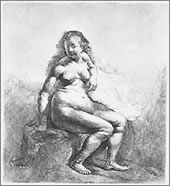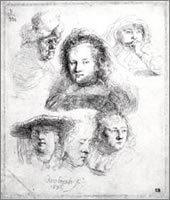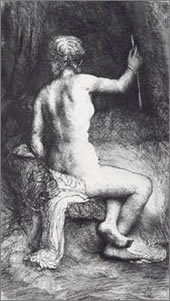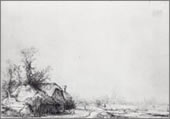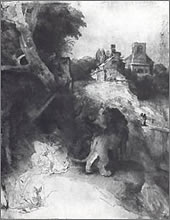
recommended book

the comprehensive Rembrandt book with a wealth of excellent images
by Gary Schwartz
2006


DVD
Rembrandt and the Technique of Etching
from:
Ed de Heer, "Technique of Etching" in Nel Segno d Rembrandt, edited by Giuseppe Bergamini and Bert W. Meijer, Venice, 1999, pp. 46-51
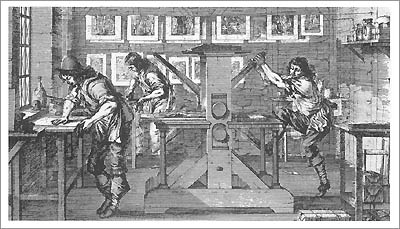
The chemical technique of etching was developed in the Middle Ages by Arabic armouries as a means of applying decoration to weapons. It flourished in the fifteenth century in south Germany, where the first etched prints on paper were printed towards the end of the century.
During the first decades of the seventeenth century Dutch artists like Esaias van de Velde, Jan van de Velde II and Willem Buytewech experimented with the technique. They were looking for greater tonality and an atmospheric effect in their landscape prints and tried to achieve this by breaking up the long contour lines into short strokes and dots.
Hercules Segers experimented with etching for a different reason: he tried to produce a painterly effect by printing on coloured paper or canvas, also working up his prints afterwards with a brush in colour and thus incidentally making every impression unique.
Rembrandt must have taken more than a little interest in these developments, for he ultimately took the technique to extremes even more than had his predecessors. In his hands, etching became a fully fledged medium which occupied him at intervals for the rest of his life. This resulted in an oeuvre of some 290 etchings, all intended as substantive works of art. Rembrandt's masterly use of the drypoint and the unique deep black of many of his etchings were famous even in his own day and his work was much sought after by the many print collectors of the time.
What follows here is a description of the technique of etching, with details of its use in Rembrandt's work. The etchings in the Rembrandt House collection cited as examples are described in the catalogue section 1.
Prints are impressions, usually on paper, of designs fixed by the artist on some kind of medium, by drawing, painting or cutting. The medium may be a wooden block, a plate of metal, or a silk screen. One of the techniques used for making prints is etching. Here the medium is a thin copper plate. This is covered with an acid-resistant mixture known as the etching ground, composed of asphalt, resin and wax. Into this thin covering the design is drawn with an etching needle, so that where the needle penetrates the etching ground the copper is exposed.
We know that Rembrandt used a fairly soft, pasty etching ground of his own devising. This allowed him to draw the design in a free, loose manner. The extent to which he was sometimes able to approach the sketch-like effect of a pencil or crayon drawing in his etchings is seen in The Bathers (a.). Rembrandt almost always drew his design straight onto the plate. True, he often drew preliminary studies on paper, but these were used only as a guideline. It was very rare for him to transfer the design of such a study onto the etching ground, as in Diana Bathing (b.)
The plate is then laid in a bath of dilute acid. The exposed parts that are no longer protected from the acid by the etching ground - that is, the lines of the design -are etched away, producing grooves in the surface of the metal. The longer the plate is left in the bath, the deeper these grooves become. If particular lines have to be deeper than others, the plate is removed from the bath, the lines that have been bitten deeply enough are covered with acid-resistant stop-out varnish, and the plate is replaced in the bath.
Rembrandt used a dilute solution of hydrochloric acid. This worked slowly and did not make thin lines coarser.
Now the etching ground is removed and the clean plate inked with an ink-pad or roller. It is then wiped clean by hand so that the whole plate is clear of ink except for the grooves. The next step is to lay a damp sheet of paper on the plate. Then plate and paper are passed through the rollers of the press. The paper absorbs the ink from the grooves, producing a reversed impression of the design on the plate. The lines that have been bitten the deepest, which therefore contain the most ink, come out darkest in the print.
This process is etching proper. Gradations in the lines can be achieved only by etching the plate more than once. However, there are also other ways of producing variation in the density of lines. The most common are working up with the drypoint and burin, drawing directly onto the copper plate. The drypoint is an etching needle with a sharp point strong enough to carve lines in the copper. As it passes through the copper the drypoint throws up a burr which retains additional ink when the plate is wiped. This makes the printed line slightly ragged or fuzzy. This velvety effect is quickly lost as the plate is used because the burr quickly wears under the pressure of the press.
The burin, which is really an engraving tool - hence its other name, graver -has a V-shaped point which cuts a sharp-edged line starting and ending in a point.
Rembrandt's first plates were pure etchings, i.e. made without recourse to the drypoint, which he initially used only occasionally for small additions or corrections. From about 1640 he became increasingly interested in the painterly effects of the velvety drypoint line: fine examples are to be seen in St Gerome beside a Pollard Willow (c.). As a result he started using the drypoint more and more often, sometimes in combination with the burin. Some of his prints, indeed, are executed exclusively with the drypoint, being drawn straight onto the copper.
If the artist is dissatisfied with the result he can alter the etched plate in a variety of ways. He can add or deepen lines by etching the plate again or by using the drypoint, but etched lines can also be erased: shallow ones by rubbing them with a burnisher so that the burr and the sides are pushed into the groove, deep ones by scraping with a scraper. Each change or addition to the plate that can be seen in a print is referred to as a new 'state' of the print. Thus state V (8) means the fifth state out of a total of eight.
Almost all Rembrandt's etchings exist in more than one state, sometimes as many as ten or more. Often the changes are slight, amounting to little more than minor additions or corrections. Sometimes they are so drastic that the result is virtually a new composition.
Only a limited number of impressions can be 'pulled' from an etching plate. The maximum is probably around a hundred; only about fifteen in the case of a drypoint plate. By the same token, prints of the same state may vary considerably as the plate and the burr become worn.
Prints were still being made from many of Rembrandt's plates at the end of the seventeenth century and even until well into the eighteenth. To disguise the fact that the plates were worn they were reworked. A good example of this practice in the Rembrandt House is the series regarding Christ preaching.
Comparatively few of Rembrandt's plates have survived. A batch of 78 plates owned in the eighteenth century by the French printer and engraver J .P. Basan carne into the possession of the American collector Robert Lee Humber in 1938. After his death this collection was sold in the London art market (spring of 1993). On this occasion the Rembrandt House succeeded in acquiring four plates (belonging to the etchings Simeon's Hymn of Praise and Five Studies of the Head of Saskia, and one of an Old Woman (e.) .
It is also possible to introduce deliberate variation by inking the plate differently. The artist can leave more or less ink in the impression..
Examples of very lightly inked prints which look almost like silverpoint drawings (the silverpoint is just that: a silver point held in wood like the le ad in a pencil. It was used on paper prepared with an opaque white coating) include other etchings In prints like the three crosses, by contrast, Rembrandt achieved a very dark effect by inking the plate heavily. One can also deliberately not quite wipe the surface of the plate entirely clean, leaving a little ink on it instead. This produces a greyish haze aver the impression. This is called 'surface tone.
Rembrandt used surface tone principally to give greater depth to shadows, as in Woman with an Arrow (Cleopatera?), and occasionally to produce an atmospheric effect in his landscapes, as in Farms and Towers Surrounded by Trees (f.).
Different types of paper (e.g. European, Japanese and 'Chinese') and vellum (made from animal skins) vary in colour and surface structure. This can be exploited to good effect. The same plate printed on different papers could produce totally different impressions.
From about 1650 Rembrandt sought increasingly to introduce variation into his prints by using different sorts of paper. Japanese paper, which was actually imported from Japan, attracted him with its warm, yellowish colour, which was particularly effective in prints of Italianate landscapes such as Christ and the Woman from Samaria (g.) and Saint Gerome Reading in an Italianate Landscape (h.). Moreover with its fine, smooth surface Japanese parer does full justice to the drypoint work. Many of Rembrandt's prints were done on Japanese paper.
A counterproof is a reversed print made by taking a freshly made print when it is still damp, laying a sheet of paper on it, and passing both sheets through the press. This produces a print of a print -the counterproof- which naturally, being reversed twice, corresponds exactly to the original design on the plate. Useful to the artist wishing to make minor adjustments to the plate.
A fine example of a counterproof in the Rembrandt House collection is that of the fourth state of The Three Crosses.
rembrandt bookshop / museums with rembrandt paintings / the complete vermeer website / rembrandt links
copyright@2018 contact




